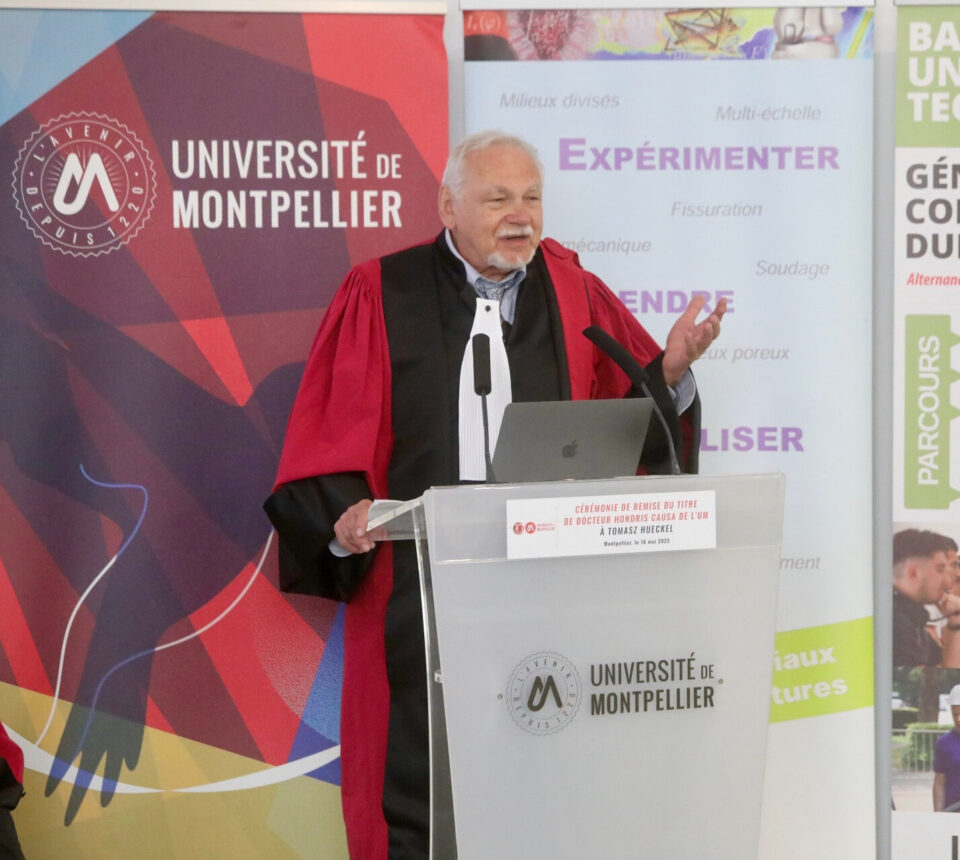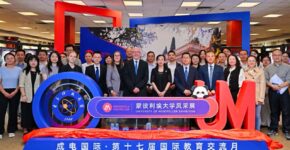Tomasz Hueckel, researcher with feet of clay
Tomasz Hueckel, Professor Emeritus at Duke University (Durham, North Carolina, USA), joins the growing community of honorary doctors at the Université de Montpellier. An engineer, researcher and teacher, he has been working for over 15 years with teams at the University of Montpellier, in particular those at the Laboratory of Mechanics and Civil Engineering (LMGC). The ceremony on May 16, 2025 was an opportunity to retrace his career step by step, from his native Poland to the United States, as well as his significant contributions to the field of civil and environmental engineering.

To get to the lectern, he uses an unobtrusive cane to move around with ease, without ever losing his generous smile. Tomasz Hueckel shines like someone who has nothing to prove. His head has been in research for over 50 years, but his feet are firmly planted. Rooted, even. In his speech, delivered in fluent French, he begins by highlighting his family roots. His father, Stanislaw Hueckel, professor of marine engineering at Gdańsk Polytechnic and member of the Academy of Sciences, " introduced him to the engineering sciences ". And his great-grandfather, botanist Edward Hückel, a true " family legend ".
Land of welcome
While Tomasz Hueckel is honored as Professor Emeritus at Duke University (Durham, North Carolina, USA), his career began in his native Poland. He studied there, graduating with distinction in civil engineering from the Gdańsk University of Technology in 1968, before going on to earn a doctorate in applied mechanics at the Polish Academy of Sciences in Warsaw in 1974 under Professor Zenon Mróz, a leading figure in continuum mechanics whom he considers one of his "masters". Caught by a presentiment, he left for Italy just two months before the communist military coup that shook Poland in 1981. Italy became his home for many years. He taught in Rome and then Milan, where he had completed his postdoc in 1975 under the supervision of Professor Giulio Maier, before moving to France to complete his training with a doctorate in physical sciences at the University of Grenoble in 1985. By this time, he was already attracting attention for his innovative exploratory research in the field of multiphysics geomechanics, with applications to underground energy and environmental geomechanics. He is interested in the ground, and even the subsoil. The subject was new: exploiting the thermo-mechanics of clay as a geological barrier for nuclear waste disposal, which involved developing a new theory of clay thermoplasticity. From 1983 to 1987, he worked with the nuclear waste storage industry at ISMES in Bergamo. Before taking the plunge and flying over the Atlantic Ocean, he headed for the United States.
Builder of multiphysics geomechanics
In 1987, Tomasz Hueckel arrived at Duke University in North Carolina as a specialist in civil and environmental engineering. Unable to continue his research into the underground storage of nuclear waste, as all programs on the subject had ground to a halt in the country, he turned his attention to chemo-mechanics. Multilingual, he collaborated with colleagues from universities in Canada and Europe: Belgium, France, Switzerland and, of course, Italy. His expertise is now widely recognized internationally. He is equally involved in research, teaching and the life of his university. Moulay Saïd El Youssoufi, LMGC researcher and Director of the UT de Nîmes, speaks of "a career marked by a real passion and a permanent commitment to fundamental and applied research in the field of soils". As a result, he has received numerous awards for his scientific work, including the IACMAG John Booker Medal in 2008 " for his pioneering work in the field of environmental geomechanics, in particular for his seminal papers on the thermoplasticity of geomaterials and on chemomechanical coupling ". He also co-founded a leading Elsevier journal in the field: Geomechanics for Energy and the Environment.
His godfather emphasizes the importance of his research: " Thanks to your work, multiphysics and multiscaling have become a requirement in any serious study of geomechanics. You are, in a way, a builder of multiphysics geomechanics and one of the world's pioneers in this field. " Citing his many innovative works, such as soil thermoplasticity and chemoplasticity, and of course the exploration of " evaporation and cracking phenomena, capillary instabilities and liquid bridges between grains ". A research theme that brought Tomasz Hueckel into close contact with the LMGC teams at the University of Montpellier, to which Moulay Saïd El Youssoufi belongs, back in 2007.
Storage of radioactive waste
Since 2008, the American-Polish researcher has been a visiting professor at Montpellier on nine occasions, co-directing research, giving lectures, co-authoring articles (around 30) and participating in the training of doctoral students and trainees. " You were also one of the few international experts to evaluate ANDRA's work on the national Cigéo project for the geological disposal of radioactive waste. Your involvement in European networks, including ALERT and IRN GeoMech, has strengthened the scientific ties between our institutions ", adds the director of the Nîmes IUT. In 2021, the scientist will receive the 2021 Geotechnical Research Medal from the Institution of Civil Engineers (London), along with Montpellier's Boleslaw Mielniczuk and Moulay Saïd El Youssoufi. A fine recognition for a long and fruitful collaboration.
In the eyes of Moulay Saïd El Youssoufi, the scientist embodies "rigor, inventiveness, humility, the sharing of knowledge and, of course, academic freedom". Which makes him, above all, " a great scientist, a transmitter of knowledge, a loyal collaborator and a friend of the University of Montpellier ". In 2023, Tomasz Hueckel will become Professor Emeritus at Duke University, where he will continue to contribute enthusiastically to research and the education of younger generations. It's a way of continuing to pay tribute to his roots, while helping to root other pioneers on both sides of the Atlantic in research.
